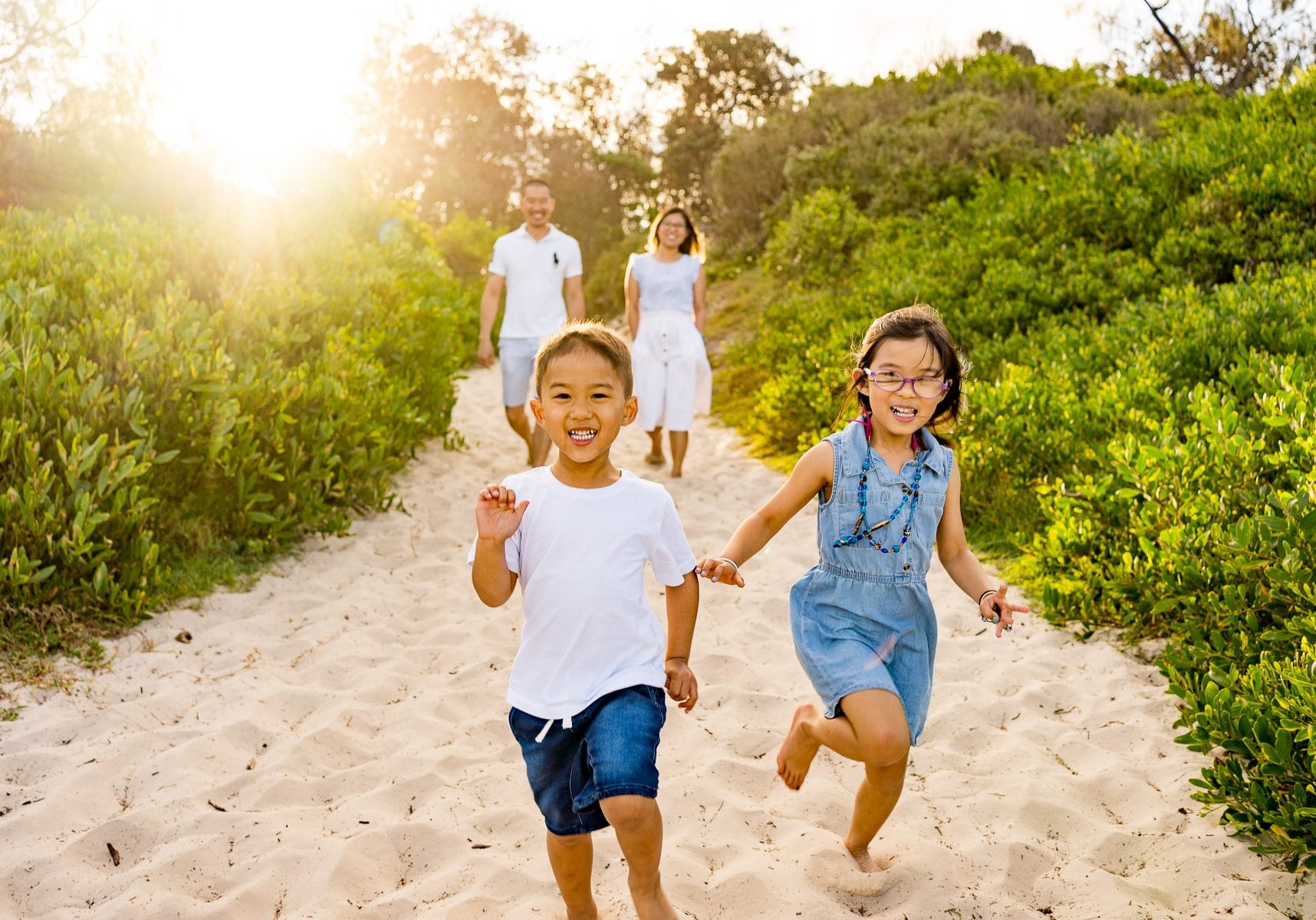
Family Photography: 18 Tips for FUN Portrait Shoots in 2024
Improve your family photography with these 18 professional tips. Read this guide and get inspiration to make your next shoot a success!
Learn | Photography Guides | By Greg Cromie
Life can move pretty darn fast – especially if you have children. One moment they’re little and before you know it they’re heading off to school or college, or into the big wide world.
Along the way, any family will have critical times and precious moments in life that are worth preserving.
By far, the best way to capture and preserve moments is with family photography. But this begs the questions; what exactly is family photography, and how can I get the most out of the process?
In this guide to family photography, we’ll cover all there is to know about this vital genre – it’s the ultimate guide for beginners. We have a massive lineup of family photo ideas and the best photography tips for family portraits.
Plus, this guide is ideal if you’re thinking of becoming your clan’s official photographer. Or, if you’re looking to take up family portraits as a paid gig, we’ve got you covered.
What is Family Photography?
Families come in all different shapes and sizes, so the definition of family photography needs to be just as dynamic. In essence, family photography is all about capturing incredible photographs of the people you love – at least it helps if you love them!
It ranges from taking a newborn baby photo to one involving all the living generations of an extended family.
The flip side is those that capture family portraits for a living – or at the least as a favour.
In most cases, family photography is less candid and far more planned. However, there’s a lot to be said for candid and incidental family portraits.
The best part about family portrait work is capturing precious memories at crucial moments of a family’s journey.
3 Family Photo & Portrait Ideas
1. What to Wear
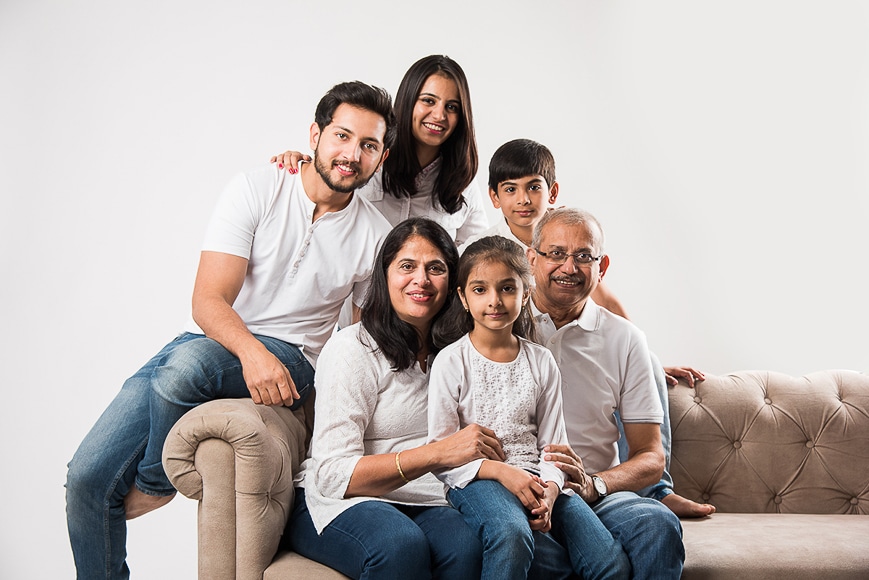
When organising a family portrait session, you can undoubtedly expect questions such as ‘What should I wear for family pictures?’ and ‘What is the best color for family pictures?’
A vital role that you play capturing family portrait shots is to help them dress for the occasion.
The most straightforward approach is to get everyone to coordinate – this is far simpler with small children than with unwilling teens. Another option is to ask them to dress for a theme.
A coordinated wardrobe serves several functions – the first of which being that you don’t have to spend your time approving clothing choices. The overall composition works better if they’re not clashing or identical in their fashion choices.
Neutral soft colors and tones always work best compared to a single shirt’s loud color. Keep it light and consider how the choices will look in the intended location. For newborn photography, be sure they pack some clothing changes for little accidents.
The key is how you communicate with the family about their choices and why they’re essential to their family portrait session. Ask what they want their photos to look like. Get them involved in the decision process to feel natural for them and reflect their family lifestyle.
You should also check out our guide to family photo outfit ideas.
2. Where to Work

It’s essential to consider the location of your family portraits. Ask questions about where they want to take the shots and how that plays into the composition. Indoors, outdoors, the local beach or even a favourite family park are ideal locations.
If the location has significance to them, it’s more likely to result in much-loved family portraits where they look comfortable.
Plan out the family portrait session’s day to consider the location and be mindful of the weather forecast if outdoors.
3. How to Pose
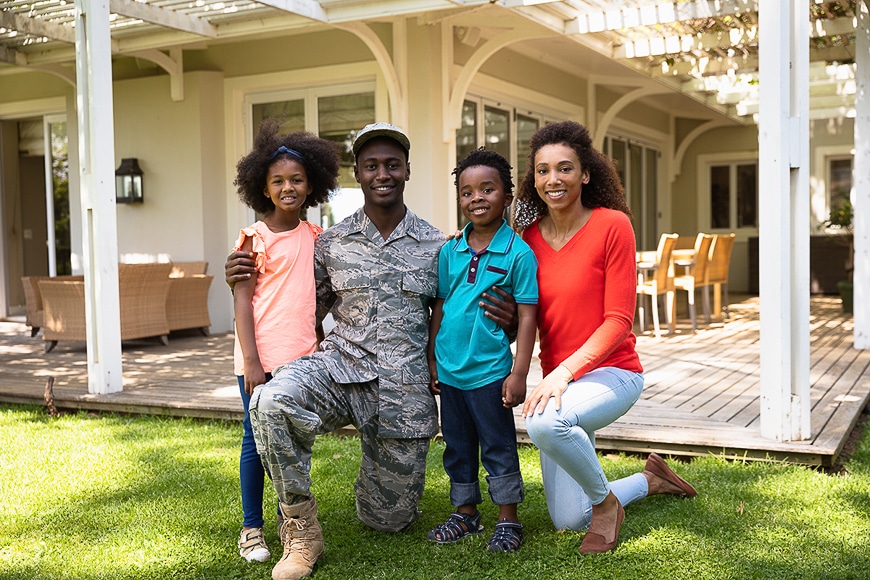
Posing other people is by far one of the most challenging aspects of any family portrait session – especially when photographing children.
How Much Do You REALLY Know About Photography?! 🤔
Test your photography knowledge with this quick quiz!
See how much you really know about photography...

If photographing young children, work with the parents to gain their support in posing the scene.
Also understand the location and what styles of poses you can work with – sitting, standing and reclining on the floor are typical.
Mixing up these styles can make all the difference to the balance of family portraits. Having the adults standing while the children sit on the floor will result in a family portrait where the viewer doesn’t know where to look.
However, having the children stand while the parents sit aligns everyone’s eye-level and make a more pleasing composition.
When working with newborns or toddlers, work lower to the floor with the parents lounging while the kids play in front of them.
One of my best tips is to work with all the family members and attempt a range of family photoshoot poses and arrangements, so they have choices when reviewing the finished photos.
18 Tips for Amazing Family Photos
If you’re wondering how you take a good family picture, these tips will help you get some authentic, candid and meaningful photos your family will cherish for years to come!
1. Get the Right Camera Equipment

Gear of family photographer Lindy Clarbull.
- Use a Suitable Camera
Regardless of capturing photos of your own family or someone else’s, your starting point is a suitable camera. Taking photographs on your phone or a point and shoot just won’t cut it – especially if you want to print your family portrait.
For the best outcomes, use a DSLR or mirrorless body – preferably one that uses interchangeable lenses.
It should have controls for aperture, ISO and shutter speed. This way, you control the photographs’ look while ensuring correct exposure.
A camera with a quality image sensor and can capture images in RAW format is preferred. RAW images hold almost all of the information captured by the sensor. As a result, you have far greater control of how you edit the photos to pull out details, control shadows and push back highlights.
If capturing families in action, you’ll need a kit that has a suitable Frames Per Second (FPS) burst mode. Shooting portraits with a high FPS captures multiple photos in succession while your subjects move.
Finally, it’s best to focus on the human eye as the point of focus. Modern DSLR and mirrorless bodies feature eye autofocus tracking. The tracking identifies a human eye and focuses on that eye – even if the person is moving.
- Lenses Fit for the Situation
Your family portrait sessions’ success relies on the quality of your lens.
Portrait photographers use prime lenses with a focal range of between 50mm and 120mm as they’re perfect for taking family shots. A50-85mm lens allows you to stand back from your subject and get their face in the photo.
It’s also an ideal lens for gaining compression where there’s no distortion of the face while ensuring minimal background space around the subject. That way, the face is the central focus with no background distraction.
Another benefit of primes is they generally have a wide maximum aperture making them ideal for blurring any distracting background elements, typical if you’re shooting inside a chaotic family home.
The other lens option for family photography is to shoot with a zoom. A zoom lens gives you greater range and the ability to zoom in on intimate details or out on larger groups. A 24-70mm zoom lens is by far one of the most popular – a worthwhile investment for your photography business.
A zoom with a fixed aperture such as f/2.8 is perfect as it allows a fair amount of light to pass through the lens while achieving a shallow depth of field.
If you’re photographing a baby, a macro lens is a great one to have in your arsenal for that all important close up shot of the baby’s hands or feet.
Having a range of lenses in your family portrait kit will ensure you’re ready for any situation, but a prime is a good starting point.
- Use a Tripod for Stability and Convenience
Any portrait photography will benefit from using a tripod and is especially the case when photographing a family.
With your kit sitting securely on a tripod, frame up the composition as though you’re ready to take the shot. Then you have the freedom to step back from the tripod and help the family members get into position and fine-tune the poses. The alternative is to have an assistant do this part for you.
When you return to the camera, you’re free to focus and fire the shutter button to capture the best look.
Here’s a list of affordable tripods.
2. Light the Scene for Correct Exposure

I could write a whole article on portrait photography’s best lighting as it’s a broad subject with countless options. Let’s look at some of the basic lighting options available to you.
- Natural Light
The use of additional lighting will always depend on what lighting is available. If shooting outdoors in daylight, there’s plenty of natural light available.
In some cases, using a flash can significantly assist the overall exposure even during the brightest days.
If the family face the sun to gain consistent light on their faces, it usually makes them squint and frown. To overcome this, have them face with their backs to the sun and use a flash to push back or fill the shadows on their faces.
The same applies to dappled light when shooting under trees. If the sunlight is directly behind someone, you can use a flash to ‘beat the sun’ and correctly expose the subject.
A perfect opportunity exists during Golden Hour either just after sunrise or before sunset. During Golden Hour, the sun’s low angle casts a warmer glow across a scene and enhances skin and hair.
- Flash
If shooting indoors, you should always consider the use of any light coming in through windows and skylights. If not, it’s time to set up additional light sources.
Fortunately, there’s a massive range of lighting solutions for photography with on and off-camera flash being the most popular choice with family photographers.
A single flash with a diffuser or bounced off the ceiling will cast an even amount of light to expose the composition correctly. Avoid using flash pointed directly at them – it will just cast ugly shadows.
Off-camera flash allows you to set up one or more flash heads to cast light on your subjects and even illuminate parts of the background. It requires a wireless trigger that attaches to the camera – it acts as a remote control for the flash heads.
The flash sits on top of a light stand fitted with a soft-box to diffuse the light. These units stand around the subjects, and at varying heights, depending on the composition you’re going for.
By far, the best tip for shooting with any flash is to practice and work on achieving correct exposures in a range of lighting conditions. That way, when it comes to capturing a family portrait, you don’t waste time trying to get the exposure correct.
3. Optimise Aperture and Depth of Field

One of the essential camera settings for capturing family life is aperture. Manual controls allow you to dial in the aperture via the body or lens.
The aperture is a diaphragm inside the lens that opens to allow light through to the image sensor.
A narrow aperture, represented by a higher f-stop number such as f/8 or f/16, results in less light passing through the lens and more of the image elements in focus.
A wide aperture, represented by a lower f-stop number such as f/1.2 or f/2, results in more light passing through the lens. It also creates a shallow depth of field that’s perfect for family portraits.
A shallow depth of field means that only a select element in the photo is focused. You can make the faces in focus, and the background elements appear as a creamy blur. The composition draws the eye to the people and doesn’t cause distraction with a busy background.
4. Control Shutter Speed to Freeze the Action
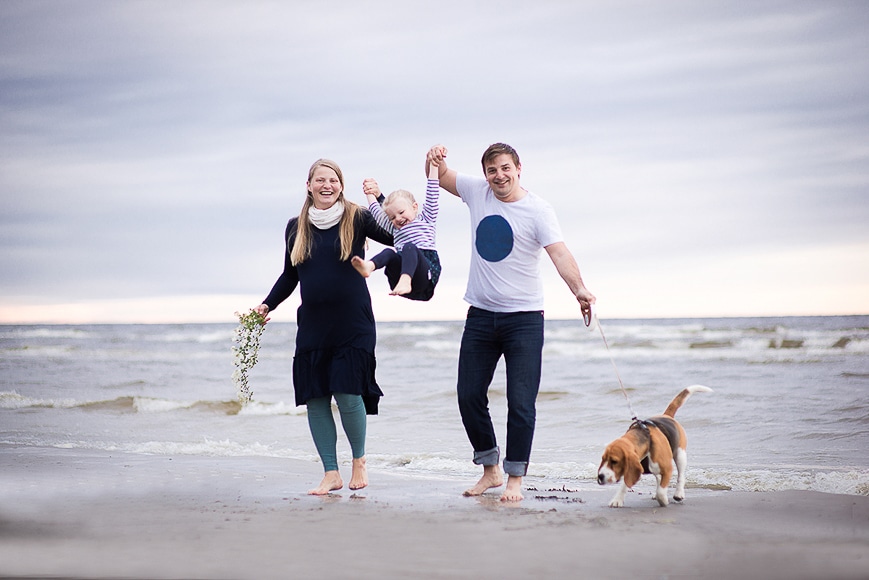
Shutter speed dictates how fast the shutter uncovers and recovers the image sensor – it joins the basic camera settings in managing exposure. It’s usually a mechanical function, but some also feature an electronic shutter that replicates the outcomes without moving parts.
Your speed choice depends on the lighting and the need to capture motion.
A fast shutter gives less time for light to pass from the lens to the sensor, resulting in a darker exposure. It will also freeze any sense of movement in the composition.
A slow shutter grants more time for the light to hit the sensor – too slow and your image will be over-exposed and useless.
Slow shutter speeds also mean any movement will be captured and appear blurred. Use this to capture portraits where the subjects are playing or involved in an activity together.
The trick is to balance shutter speed and aperture to expose the image and freeze the moment in time correctly. A good starting point is to work within the 1/125 and 1/500 second speeds.
5. Use ISO to Master the Light
In short, ISO is the camera settings that control the light’s sensitivity as it hits the image sensor.
In bright settings such as full sun, ISO should be dialled right down to its lowest. In darker scenes, especially with no additional light sources, ISO can be dialled-up to improve the exposure.
Be wary of high ISO in darker settings that result in family images with noise – it appears as grainy artefacts where individual pixels are not exposed correctly.
Even though you can reduce noise in photos using certain software tools, my advice is to keep ISO low by managing aperture, shutter speed, and additional light sources.
6. Get to Know the Family
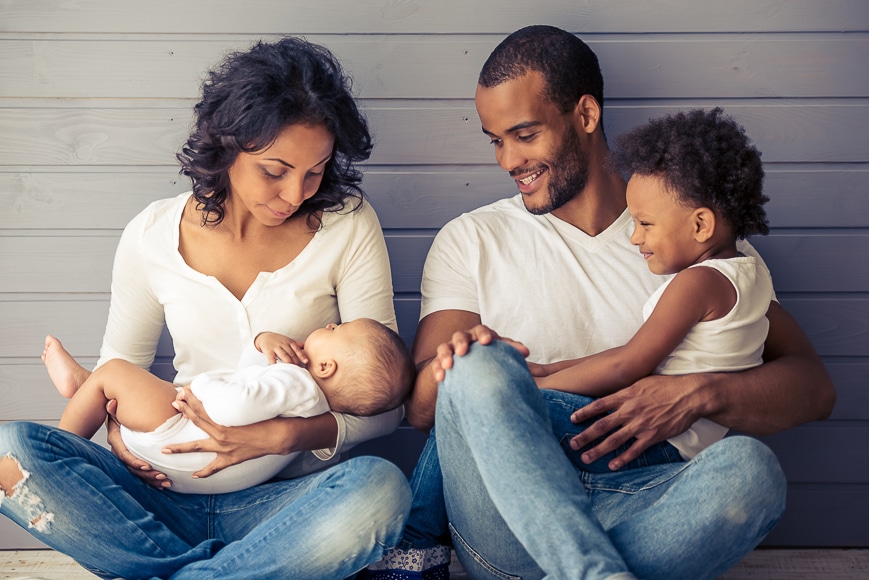
This genre permits you to enter a family’s private-world and capture them at their best (hopefully).
The quick route to failure is to have them show up to a foreign location and expect them to feel relaxed while telling them how to stand.
Take the time to meet the family beforehand – ideally at the shoot location to chat about their family and expectations for the final family portrait.
If possible, visit the family at their home and learn a little about them. Learn their individual and united interests to develop talking points during the shoot. Discover what makes them laugh and what sort of things the children are interested in.
It will go a long way to putting them at ease and drawing out shy children.
7. Plan for A Successful Family Portrait
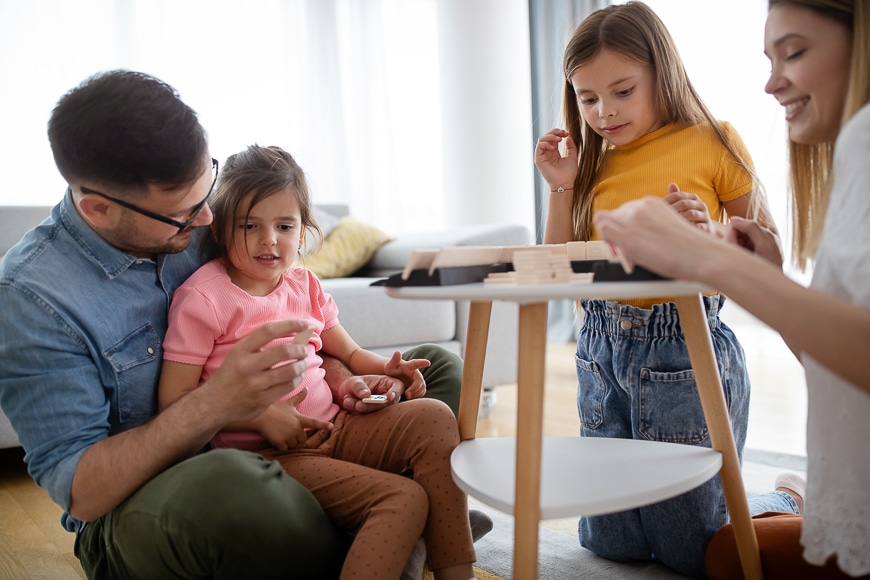
Planning a family portrait session is not without its challenges – especially with small children or reluctant teens involved.
That’s why getting to know the family before the shoot is so critical. It allows you to learn about their individual and group routines.
It’s critical with newborns and small children to plan around their routine as they’re often the least flexible due to meal and nap times.
Planning includes understanding the location – if it’s an outdoor spot, consider visiting it before the portrait shoot.
Make sure to arrive at the same time you intend to do the shoot. This way, you’ll see the lighting conditions, the sun’s position and the number of people visiting the same spot.
A plan ensures you work with the client to determine the best time of day for the portrait session.
8. Don’t Forget the Family Dog
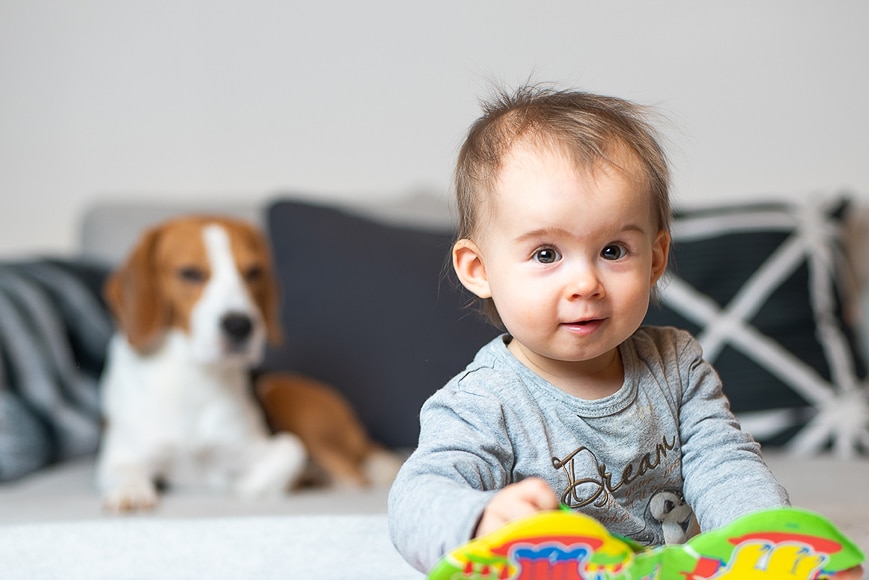
Many families have pets as part of the clan and want to include them in the portrait.
Including the dog, cat or hamster is a challenge, but it also works in your favour. The challenge with pets is that they’re even less responsive to posing suggestions than children.
The benefit is that a pet provides a focal point for children or the whole family.
If the pet proves to be too great a distraction for the children, make sure to capture your family portrait with and without them.
9. Consider Indoor Locations

Families often want to capture their memories within the home.
Before the shoot, take a walk with them around the home and out to the garden. Discuss possible locations within the house for family portrait photography.
Consider family images of everyone snuggled-up together on the lounge or perhaps sitting on the floor of the playroom.
Make sure to evaluate the composition, including the background elements and lighting conditions.
Avoid distractions in the room, especially as small children will show you every toy they own!
10. Head Outdoors
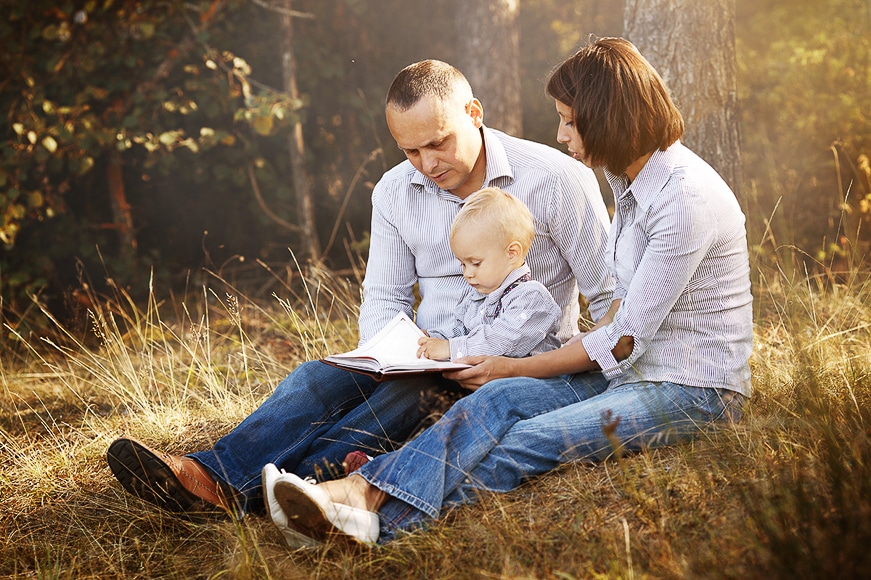
Outdoor locations are trendy for family portrait photography.
For one, natural lighting is easier to allow for and avoid additional lighting. Plus, being outdoors will change the mood and behaviour of younger members of the group.
An active family that loves being outside will probably opt for an outdoor shoot. When planning, learn what their favourite outdoor locations are – take the time to visit them.
If they don’t have a favourite location, have a couple of your favourites ready. These are places that you have likely photographed before and know the lay of the land.
11. Use Incidental Locations
If you’re away on holidays with your family, consider this an incidental location and take some shots.
While away or relaxing at a beach resort, you have the perfect opportunity to capture stunning photographs and great holiday memories.
Other incidental locations may include the local playground or a sporting event that the family attends regularly.
Alternatively, take the opportunity to capture the family interacting in an everyday task or a rare get-together.
12. Make it Fun for Everyone
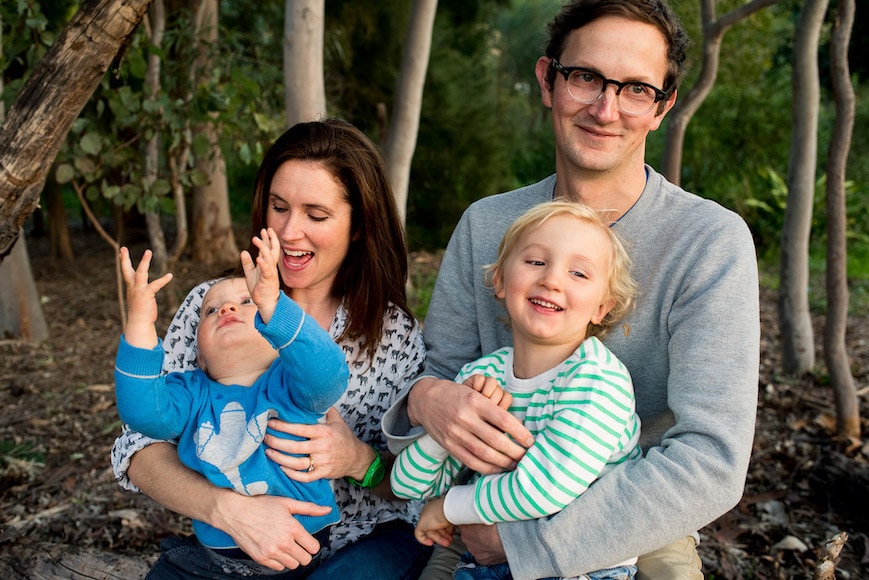
Photographing families is an excellent opportunity to have fun, draw out the natural joy of family times and represent each personality.
The best approach is to make it fun for everyone. Create fun nicknames for children based on their personality to help keep them on your side.
If they’re young, don’t be afraid to play with them or use their playful nature in how you capture them in your photos.
Encourage playfulness in all family members and take great shots of them in a tickle fight or laughing at one another. These kinds of candid impressions often turn out to be the best of the bunch.
What’s more, the family has a positive experience working with you, which is always good for business.
13. Clean up Your Act
It’s essential to be on the lookout for things that make you slap your forehead when editing. There’s nothing worse than getting a perfect exposure, pose and a magical connection with your subjects only to find that tourists were strolling in the background.
Be on the lookout for background elements that will impact the composition. Fences, parked cars and even items around the house can change the look and flow of your images.
Also be sure to give your subjects a thorough inspection to make sure no one has sunglasses on their head, hair across their face, untucked shirts or chewing gum.
14. Keep All Eyes on You

It’s time to press the shutter button, but how do you get a group, including three toddlers, to look at you at the same time.
There’s a reason why people use the popular call-outs of ‘Everyone Say Cheese’ or ‘Smile For The Birdy’. Some photographers make up their own or hold an exciting toy above the camera with small children.
I get everyone to be a Tiger and turn their hands into claws. They crouch a little and then make their best attempt at a growling tiger face. It’s a lot of fun and gets everyone involved in looking at me.
Now that I have the family smiling and loosened up, I hold their attention long enough to make their pose and look at the camera.
15. Look For Fresh Perspectives
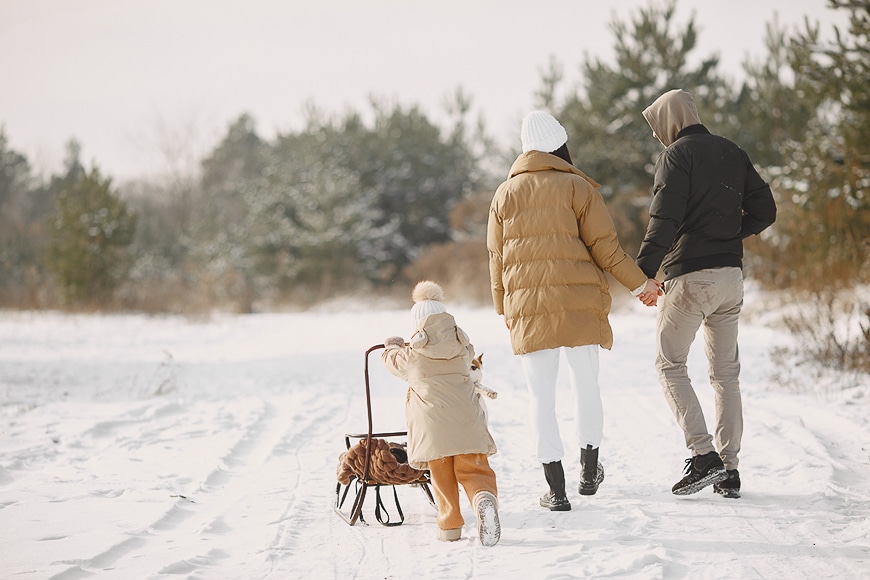
While there’s a common trend of having your camera held or on a tripod at eye-level, consider looking for a fresh perspective.
Shooting from a lower angle at close range rarely works unless you’re going for a fun family portrait with an ultra-wide lens.
Consider working from a higher angle or even at a diagonal. Instead of photographing them face-on, the family lined up, step aside to shoot them from an angle – or shoot them from behind.
I’m not suggesting you hang from a tree, but there are some photographers out there who carry around a stepladder for a reason.
The trick is making the most of your time to capture several looks and views to gain interest with the finished product.
16. Include Drone Photography

While drones are not considered essential for family portrait photography, they add a unique element.
Consider using a drone from above to capture a family strolling along a completely deserted beach with the ocean to one side and the sand to the other.
Alternatively, for an active family, use a drone to capture a stunning photo of them at sunset standing atop a cliff or outcropping of rock.
An easy one that’s always fun for the kids is to have everyone lay down on the ground and simply look up at the sky. This obviously works best when it’s a cloudy day, to avoid squinting!
17. Color Vs Black and White
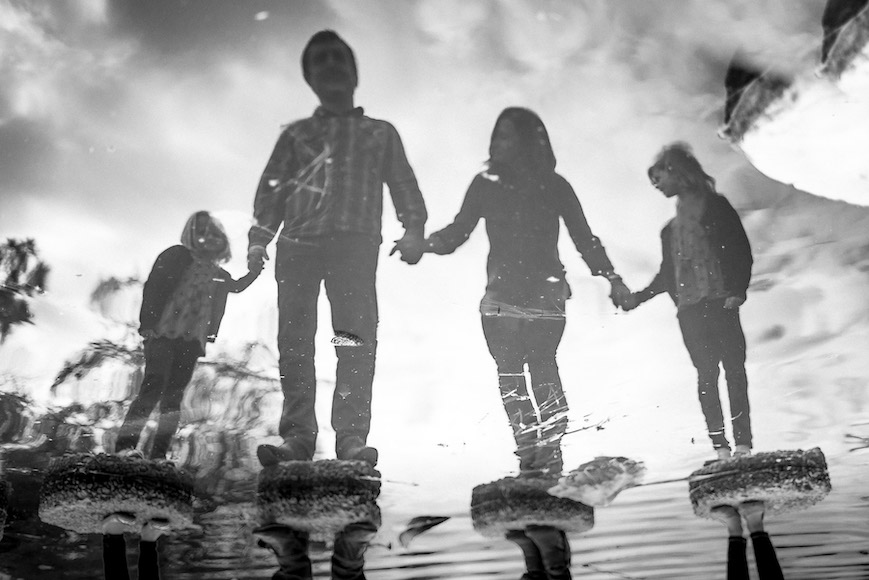
Black and white photography for portraits has never grown old.
Consider shooting in or editing a family portrait in black and white – this is in addition to a collection of color images.
Black and white or monochrome edits add a lot of character. The tonal values take responsibility for texture and contrast and detail with the color removed.
B&W edits often bring delight and nostalgia to a family upon receipt of their finished shots, since it’s something out of the ordinary, perhaps reminding older family members of the film era of photography.
18. Shoot Candid Family Photography
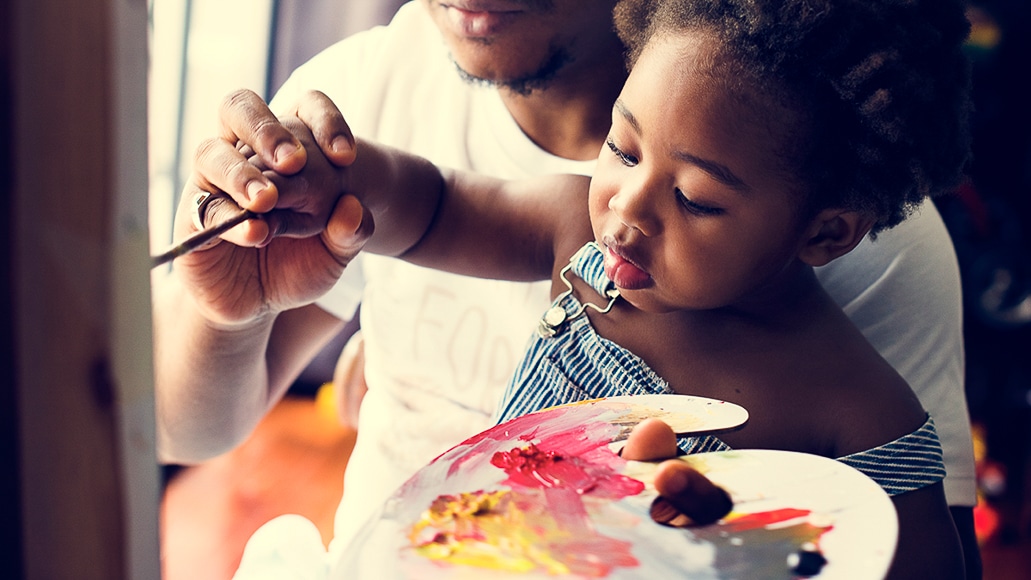
Family photography involves ‘serious’ portraits, where the scene and poses are all staged. It’s a necessary form of documenting milestones and growing families.
But it’s also worth considering candid or documentary photography. A fast-growing discipline adding new elements to documenting family life is a candid photo opportunity.
Much like candid wedding photography, it captures the family going about their business. For kids, their business is playtime and photographing kids unaware of the gear or the need to pose is priceless.
Candid family photography captures the natural expressions and reactions of a family as they interact. You cannot replicate that in a posed photo.
Family Photography FAQs
How much does it cost for a family photography shoot?
Depending on your region, it costs between $100 and $400 per hour for a family portrait session. It doesn’t always include the cost of prints or files so ensure you discuss all costs with the photographer.
Why is family photography important?
Family photography is vital as it allows for precious memories and times in our lives preserved forever. The quality of professional family photography is far greater than the snaps you have in your phone image library.
How much do family photographers make?
There are many variable factors, but on average, family photographers can expect to earn between $300 and $800 for a two to three-hour session.
Final Words
If you intend to capture stunning photographs of your tribe, you now have all you need to get started.
If you’re thinking of working as a portrait photographer, there’s no better time than right now. With the growing demand for quality content shared across online platforms, the need for this kind of work has never been higher.
For the photographers operating in this genre, leave your comments and even your tips. Above all else, join the conversation and feel free to ask questions about your next family portrait session.

Check out these 8 essential tools to help you succeed as a professional photographer.
Includes limited-time discounts.













